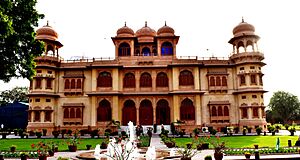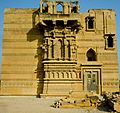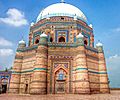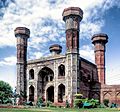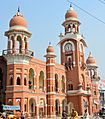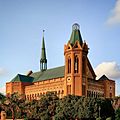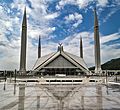Pakistani architecture facts for kids
Pakistani architecture shows many different styles from various times in history. It all started around 4,500 years ago with the Indus Valley civilization. This was a very advanced city culture. They built large structures, and some of these buildings can still be seen today. Later, the Gandhara style of Buddhist architecture became popular. This style used ideas from ancient Greek buildings. You can still see parts of this style in Taxila, which was once the capital of Gandhara.
Contents
Ancient Buildings: From Indus Valley to Early Kingdoms
Pakistan's building history is very old. It began with the Indus Valley civilization, one of the world's first great civilizations.
Indus Valley Civilization: Early Cities
Around 2500 BC, people in the Indus Valley built amazing cities like Mohenjo-daro and Harappa. These cities were well-planned. They had straight streets and a good drainage system. Buildings were made from baked bricks. A famous example is the Great Bath in Mohenjo-daro. It was a large pool used for special ceremonies. These cities show how clever ancient people were at planning and building.
Gandhara Architecture: Greek and Buddhist Styles
After the Indus Valley period, the Gandhara region became important. This area is now parts of Pakistan and Afghanistan. From the 1st to the 7th century AD, a unique style of Buddhist architecture grew here. It mixed Buddhist ideas with art styles from ancient Greece. This happened because Alexander the Great's armies had come to the region.
Stupas and Monasteries: Places of Worship
Gandhara architects built many stupas and monasteries. Stupas are dome-shaped buildings that hold important Buddhist relics. Monasteries were places where monks lived and studied. Famous examples include Takht-i-Bahi and Jaulian. These sites show detailed stone carvings and statues of Buddha. The Dharmarajika Stupa in Taxila is another great example. It shows how different cultures influenced building styles in ancient Pakistan.
Hindu and Jain Temples: Stone Carvings
Later, Hindu and Jain temples also appeared. These temples often had beautiful stone carvings. The Katas Raj Temples are a group of Hindu temples from the 4th century. They show a unique style found in Kashmir. The Amb Temples were built between the 7th and 9th centuries. In the Tharparkar District, you can find ancient Jain temples like the Gori Temple. These temples have detailed frescoes and carvings. They show the rich religious history of the region.
Islamic Architecture: Grand Mosques and Tombs
With the arrival of Islam, a new style of architecture began in Pakistan. This style often featured domes, arches, and detailed tile work.
Early Islamic Structures: Simple Beginnings
The first Islamic buildings were simpler. They focused on function. Over time, they became more grand. Early tombs, like the Tomb of Shah Yousuf Gardezi in Multan, show the start of this new style. The Chaukhandi Tombs near Karachi are also famous. They have very detailed stone carvings.
Mughal Architecture: A Golden Age
The Mughal Empire (16th to 19th century) brought a golden age of architecture to Pakistan. Mughal buildings are known for their grandeur, symmetry, and use of red sandstone and white marble.
Lahore's Mughal Wonders: Forts and Mosques
The city of Lahore became a center for Mughal building. The Lahore Fort is a huge complex with many beautiful palaces and gardens. Inside, you can find the Naulakha pavilion and the Moti Masjid. The Wazir Khan Mosque is famous for its colorful tile work and frescoes. The Badshahi Mosque is one of the largest mosques in the world. It has grand minarets and a huge courtyard. Other Mughal structures include the Shalimar Gardens, Lahore, the Akbari Sarai, and the Tomb of Jahangir. These buildings show the power and artistry of the Mughal emperors.
Other Mughal Gems: Across Pakistan
Beyond Lahore, Mughal architecture can be seen in other cities. The Mahabat Khan Mosque in Peshawar is a beautiful example. The Shah Jahan Mosque, Thatta in Thatta is known for its unique brickwork and blue tiles. The Chauburji in Lahore is a monument with four towers. These buildings show how Mughal style spread across the region.
Sikh Architecture: Unique Designs
After the Mughals, the Sikh Empire also left its mark on Pakistani architecture. Sikh buildings often feature golden domes and intricate designs. The Gurdwara Dera Sahib in Lahore is a famous Sikh temple with a golden dome. The Samadhi of Ranjit Singh is a memorial building that also shows Sikh architectural elements. These structures are important religious and historical sites.
Colonial and Modern Architecture: New Influences
In the 19th and 20th centuries, British colonial rule brought new building styles to Pakistan. Later, modern architecture emerged after Pakistan became independent.
British Colonial Style: European Touch
The British built many buildings in a European style. They often mixed European designs with local elements. Examples include the Lahore Museum, designed by Sir Ganga Ram, and the King Edward Medical University in Lahore. The Karachi Metropolitan Corporation Building, Frere Hall, and Hindu Gymkhana Karachi in Karachi are also examples of this period. These buildings often used red brick and had grand, formal designs.
Post-Independence Architecture: New Identity
After 1947, Pakistan started to develop its own modern architectural identity. Builders began to combine traditional Islamic designs with modern building techniques.
Iconic Modern Structures: Symbols of Pakistan
The Minar-e-Pakistan in Lahore is a famous example. It is a tall tower that marks the spot where the resolution for an independent Pakistan was passed. The Faisal Mosque in Islamabad is another iconic building. It has a unique modern design inspired by a desert tent. The Pakistan Monument in Islamabad is a modern structure shaped like blooming petals. These buildings represent Pakistan's journey as a new nation.
Other Modern Buildings: Cities Grow
Modern buildings like the Teen Talwar monument in Karachi and the Karachi Chamber of Commerce Building show how cities have grown. Schools like Sadiq Dane High School and universities like the University of the Punjab also feature modern designs. These structures reflect the country's progress and changing styles.
Images for kids
-
View of Mohenjo Daro towards the Great Bath.
-
Tomb of Shah Yousuf Gardezi, Multan
-
Naulakha pavilion (1633) in the Lahore Fort
-
Alamgiri Gate of the Lahore Fort
-
Darbar Sahib, gurdwara commemorating Guru Nanak, in Kartarpur, Pakistan
-
Samadhi of Ranjit Singh in Lahore, an example of Sikh architecture in Pakistan
-
University of the Punjab, Lahore
-
The present building of the Lahore Museum was designed by Sir Ganga Ram and completed in 1894
-
Moti Masjid located within the Lahore Fort
-
A Mughal era monument - Chauburji in Lahore
-
Sadiq Dane High School, Bahawalpur
-
Patiala Block of King Edward Medical University, Lahore
-
Multan Clock Tower, Multan
See also
 In Spanish: Arquitectura de Pakistán para niños
In Spanish: Arquitectura de Pakistán para niños


